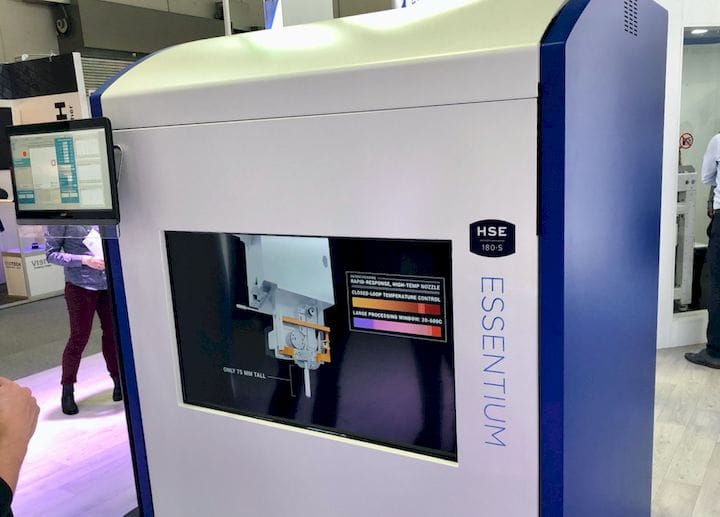![The revolutionary HSE 180•S from Essentium [Source: Fabbaloo]](https://fabbaloo.com/wp-content/uploads/2020/05/image-asset_img_5eb0a1be69b97.jpg)
Call us impressed. Essentium’s new HSE 180•S seems like a 3D printer utterly different from its competitors.
The new machine, the HSE 180•S, includes so many hardware innovations it’s hard to list them all. I have not seen a machine so radically different – yet using the same, familiar filament-based 3D printing process.
The resulting machine has seemingly unbelievable specifications, such as the ability to 3D print at spectacular speeds of up to 500g per hour, or a hot end that can hit 600C – in only THREE SECONDS!
How they arrived at this machine is a bit of a historical tale.
When we first encountered Essentium a few years ago it was a very small startup that had invented a revolutionary way to 3D print filament using electrical heating – through the filament itself. An electrical current flowed from the hot end through the material to the print plate. The material used electrical resistivity to create heat that fused the material together in very strong fashion, hence the name “FlashFuse”.
At that time they were attempting to coax other 3D printer manufacturers to incorporate their revolutionary technology into their equipment. However, it seems they had trouble doing so, as we saw very few, if any, other machines incorporating the FlashFuse technology.
So they were a materials company with a technology that had no machine to receive it. Evidently they must have made the decision at some point to simply build their own machine.
Now it gets interesting.
They recruited people to do so not from the 3D printing industry, but instead from the semiconductor industry. These folks were used to machines that produced computer chips, where, for example, wire bonding machines would move quickly to place tiny wires leading to the chip. An Essentium spokesperson told us that “if you could see the machine, it was moving too slow”.
This is the background of some of the designers of the HSE 180•S.
Apparently they began their investigation by obtaining a common desktop 3D printer and started it up. As it moved slowly to extrude material in its expected manner, the semiconductor folks asked, “when does it speed up?”
It didn’t.
Thus they essentially rejected much of the current thinking on how to build mechanical systems for 3D printers and devised their own from scratch, based on their previous experience.
The HSE 180•S includes all linear motors, for example. They employ several very high speed processors for motion control. They use powerful servo motors instead of steppers for accuracy. They use multiple highly customized components. They beefed up the extruder to push with 10-15X the typical force in other systems. The print surface can hit 200C. They simplified the machine design so that it apparently includes only seven moving parts, not including the chamber door. They instrumented all the components to track and tune the motions, temperatures and other factors to the ultimate degree.
The result of all these improvements is a radically fast machine and accurate machine. We were told the motion system is accurate to up to 30 microns positioning, which is incredible at such speeds. We saw – but were not allowed to photograph – a HSE 180•S ripping through a successful print at a speed never seen in public, and this was with standard 1.75mm filament – no pellets required. Movement speeds were faster than 1m/second! Their redesign approach to achieve 10X print speed improvements definitely worked.
Some other more standard improvements have been incorporated into the design, including a sapphire nozzle that is capable of handling composite materials like metal and carbon fiber. The nozzle should be able to handle over 50kg of such material before requiring replacement.
The HSE 180•S is also a rather large machine, with a build volume of 740 x 510 x 650 mm. Combined with the extreme print speed, the machine should offer a good way to rapidly produce large objects.
I’m very impressed with the HSE 180•S and even more impressed with their approach to its design. The improvements they’ve achieved could change the expectations of many when shopping for 3D printers.
One more thing: the price of the HSE 180•S is only US$75K, lower than many industrial filament machines of considerably less performance.
Essentium also announced a partnership with BASF and Materialise during formnext, pointing to larger plans for strong 3D printing going forward.
Via Essentium












2 comments
Comments are closed.